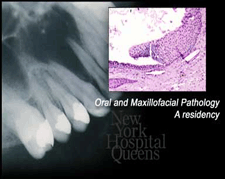المقالات
Epithelial Dysplasia

Epithelial dysplasia refers to microscopic changes in the cells that makeup the outer layer of the mouth's lining (the mucosa), similar to changes usually seen in cancers in the same location. The changes associated with epithelial dysplasia can occur at any site in the mouth, but are most common on the tongue, lips, and the floor of the mouth. Men between the ages of 50-70 are most susceptible to these lesions, particularly if they have a history of tobacco or alcohol use, or if other oral cancer risk factors are present. Epithelial dysplasias are classified as mild, moderate and severe, depending on the extent and severity of the cellular changes.
Epithelial dysplasia is usually associated with a color change in the affected tissue, usually to red and/or white. The lesions associated with this condition tend to be white plaques, either rough or smooth, or velvety red spots or plaques. They may produce a burning sensation, or no symptoms at all, and can thicken, harden or expand. The condition's cause is unknown, but it can transform into invasive carcinoma (cancer), so it should not be ignored.
Because there is a chance these lesions can become cancerous, it is important that we remove them as soon as possible.
* We can remove small lesions (under two centimeters) surgically in their entirety. It is of utmost importance that we submit this tissue for microscopic diagnosis, preferably to an oral and maxillofacial pathologist.
* If the lesions are very large, it is often wise to take a sample (biopsy) of tissue for microscopic diagnosis. If there is no significant dysplasia, we will remove the remainder of the lesion using cauterization, cryosurgery (freezing), or with a laser.
* We will follow these lesions on a routine basis to check for recurrence or for developing new lesions.
